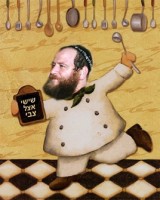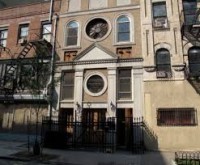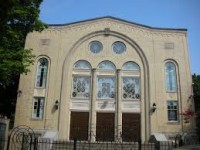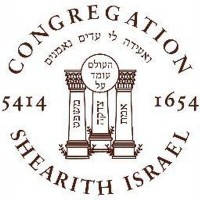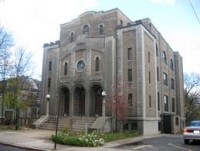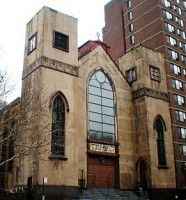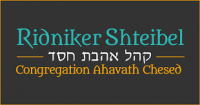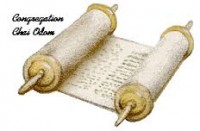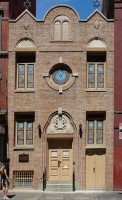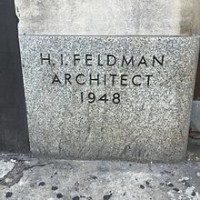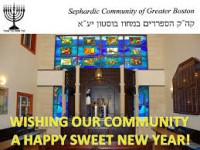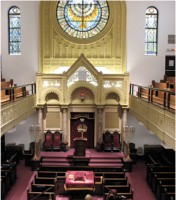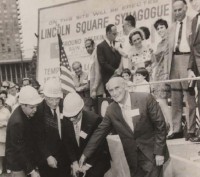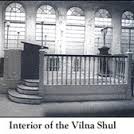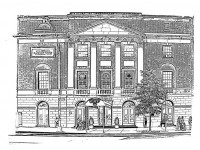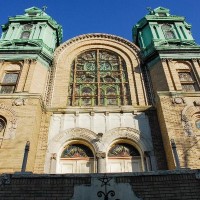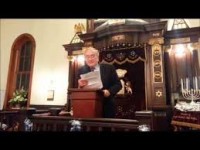מיטל וצבי וילור צידון נישאו זה לזו בניו-יורק ב-2006. לצד ההחלטה על חיים משותפים רקמו השניים החלטה נוספת: לעשות משהו טוב למען הקהילה הישראלית בניו-יורק. מיטל וצבי רצו לחבר בין הישראלים הרבים שחיים בעיר ולספק להם מקום של חוויה יהודית וישראלית אותנטית. מזה שמונה שנים שמיטל וצבי מזמינים מידי יום שישי ישראלים רבים לארוחת שבת חגיגית אצלהם בבית בקווינס, פרויקט המוכר בתור "שישי אצל צבי".
"התחלנו מיד כשהתחתנו", מספר צבי. "אנשים תמיד אומרים, 'אל תתחבר עם ישראלים! ישראלים, במיוחד כאלה שחיים בחו"ל, הם אנשים קשים'. אבל אנחנו רצינו להראות צד אחר של הישראלים, להראות שאנחנו אנשים טובים ויפים. רצינו לחבר ולאחד את הישראלים, להוציא את הצד הטוב והיפה, שיהיה ישראלי מאוד. כשהתחלנו את 'שישי אצל צבי' גרנו בבית ממש קטן, עם מטבח קטנטן, אז התחלנו בקטן. בהתחלה היו באים רק שישה אנשים ומיטל התלוננה שלא מגיעים מספיק אנשים. אבל ידענו שאם נחכה ונתמיד בסוף זה יתפוס. ובאמת, לאט לאט, חבר הביא חבר וזה התחיל לתפוס. פתאום היינו שמונה אנשים ואחרי זה עשרה. היום, כל שבת, ברוך השם, יש אצלנו בבית בערך שלושים אנשים. בחורף, זה נע בין עשרים לשלושים איש, ובקיץ יושבים גם בחצר ומגיעים בין שלושים לארבעים איש. בראש השנה יושבים אצלנו בסלון, בחדר האוכל והחצר ביחד גם חמישים-שישים איש. ובל"ג בעומר האחרון היו אצלנו שבעים איש, שחגגו על-האש בחצר".
כשהוא לא מתפקד כבית חב"ד של איש אחד ואישה אחת, צבי מנהל חברה לשיווק באינטרנט ועוסק בהקמת אתרים וקידום בחיפושים. החברה שלו גם זכתה פעמיים ברציפות בפרס לקידום אתרים מטעם גוגל. אבל נראה שהמצווה של אירוח עשרות ישראלים לחוויית שבת מיוחדת מידי שבוע היא בעלת חשיבות לא פחותה מבחינת צבי, ובהחלט לא פחות תובענית מבחינת זמן ומשאבים.
איך אתם מכינים ארוחה לשלושים איש מדי שבוע?
"זה פרויקט שאנחנו עובדים עליו כל השבוע. ביום שלישי אני עושה את הפרסומים על מנת שזה יופיע בכל מקום וכדי שאנשים ידעו שיש להם לאן לבוא לשבת. אני מפיץ את הידיעה באינטרנט ובפייסבוק, ואני שולח הודעות טקסט לרשימת תפוצה של 200 אנשים. אחרי זה אנחנו עושים קניות בימים רביעי וחמישי. ביום חמישי אנחנו מתחילים את הבישולים. אנחנו כבר כל כך מיומנים בבישולים בכמויות האלה, שבדרך כלל אנחנו גם משלימים את הבישולים עוד לפני יום שישי. את הכל מיטל ואני מבשלים, לפעמים עם קצת עזרה מחברים".
למה יכול לצפות אורח בשישי אצל צבי?
"בארוחות 'שישי אצל צבי' הכי חשוב זה האווירה. יש אווירה נעימה ונינוחה, בלי ויכוחים ורעשים. יש אצלנו אווירה ביתית של שבת, עם קידוש ושירים, חלה ונרות דולקים. יש ארוחה גדולה, שהאורחים עוזרים להגיש, כמו בבית, ואחרי הארוחה הרבה מהאורחים נשארים לשבת, שרים ומדברים. מאז שהתחלנו כבר נוצרו אצלנו הרבה קשרים וחברויות וגם כמה חתונות שהתחילו אצלי בבית. מבחינת האוכל, אנחנו מכינים את הכל בעצמנו בבית. אנחנו משתדלים שלא להגיש שום דבר קנוי או מוכן מראש. בכל ארוחה אנחנו מגישים עשרה סוגי סלטים, חצילים וטחינה וחומוס שאנחנו מכינים. אנחנו מגישים מרק צמחוני, דג מרוקאי ובשר ועופות ותוספות לצמחונים, וקינוחים. כמעט לא קונים שום דבר תעשייתי. אנחנו רוצים שהכל יהיה ביתי וטרי ואורגני וכמה שיותר בריא".
איך מכלכלים ארוחה גדולה כל כך מדי שבוע?
"בשבע שנים הראשונות עשינו הכל לבד וכלכלנו כמעט את הכל מכיסנו. השנה אמרתי שנעשה ניסיון ונבקש סכום סמלי מכל אורח. כשהתחלתי לפרסם את הארוחות בתשלום, פנו אלי כל מיני אנשים ואמרו, 'צבי, עזוב אותך, אל תיקח כסף על הארוחה ביום שישי הקרוב, אני אשלם על הכל'. וככה יצא שאנשים טובים מכסים את ההוצאות כמעט בכל הארוחות מאז, ואנחנו יכולים להמשיך ולהזמין אורחים ללא תשלום".
בעמוד הפייסבוק של "שישי אצל צבי", חולקים צבי ומיטל בוידאו את המתכונים שלהם בעת ההכנה של הארוחות. אפשר למצוא שם בין היתר מתכונים מצולמים של עוגת תמרים פרווה ללא אפייה, חלות ארבעה דגנים או דג סלמון כבוש. הם גם חולקים עשרות מכתבי תודה והערכה משלל האורחים שביקרו בביתם.
איזה מין אנשים מגיעים לארוחות "שישי אצל צבי"?
"אני אוהב להגיד, 'בשישי אצל צבי, כל אורח הוא VIP'. מגיעים ישראלים מכל הבא ליד – סטודנטים, רופאים, בנקאים ואנשי נדל"ן. לפעמים מגיעים תיירים ישראלים שנמצאים בסביבה, או דיילות של אל-על. כל מי שרוצה לבוא מוזמן. אני רוצה להפיץ את הידיעה על 'שישי אצל צבי' כדי שעוד אנשים ידעו על זה שיש להם מקום לבוא בסוף השבוע לארוחת שבת ישראלית ולהיחשף לצד היפה של הישראלים כאן".
Your most heroic acts are those of which you may not even be aware.
Like the time you could have gotten even with the guy in the next cubicle, and nobody would have known. And you really wanted to. But you didn’t, just because it’s not right.
You may not have been impressed—you may even have been disappointed with yourself. But the angels burst into song, as all your world rose up a notch. It may have been the most elevating act of a lifetime.
Heroic acts are not heroic if they’re second nature. It’s when you break out of your nature that you enter the realm of the divine.
B"H We are all heros. We are all filled with the glory of God.
The difference between "the best of us and the worst of us" is a VERY fine line and moves with time.
Redemption and return to God is just a moment and thought away. A desire.
Rv. Freeman, the lessons are from God, with your sweet expression.
Thanks to God, through you on this Thanksgiving day.
Shalom,
how great to know that not only in general we are important, but every moment of our life!! we are the main actor and HASHEM is our main audience and our "Oscar" is His approval and joy.
We’re doing something special for Purim this year, and the more of you participate, the more special it will be! Sign up for our first-everMishloach Manot Project to send your friends and fellow Stanton members traditional Purim food baskets. We prepare them for you, you sit back and enjoy Purim, proceeds go to the shul, and everybody wins!
How does it work? You should already have received an e-mail with instructions and your very own log-in code. Simply log-in to the Purim Project site and select the people you want to send to from the list of participants ($5/person or $180 for as many names as you want). The baskets will be available to be collected at the shul on Purim night,March 23, and Purim morning, March 24, when you come for megillah reading. (Please note, each participant receives one basket with a list of all the people who gave to them.)
We are honored to host the Honorable Martin Shulman this Shabbat, February 6, for a special talk in honor of Parashat Mishpatim (Laws). Judge Shulman’s talk on “Selected Torah and Secular Social Laws – No Need to Re-invent the Wheel,” will take place at 12:15pm, after kiddush, and will be followed by mincha. All are welcome!
Celebrate Shabbat with Stanton and the rest of America next week!
We will be having a community Shabbat dinner on Friday night,March 4, for the nationwide Sabbath observance known as Shabbat Across America. Click here to sign up now! The cost is $35/person or $30 for shul members. Sponsorships of $100 include dinner for two. Please let us know if you would like a vegetarian entree.
Temple Beth Shalom, also known as the Tremont Street Shul, is a warm, friendly, traditional Jewish synagogue located near the center of Cambridge, Massachusetts. We embrace a wide variety of ages, backgrounds, and styles of worship. On Shabbat evening and morning we have two styles of services. Shabbat morning services are followed by a sit down Kiddush lunch to which everyone is welcome.
HISTORY
Temple Beth Shalom was formed when Temple Ashkenaz and Congregation Beth Israel merged in 1962. The merged Shul chose to use the Temple Ashkenaz building at 8 Tremont Street because it was newer. The name was changed to Temple Beth Shalom, in part to mark a new spirit of community cooperation.
As members of the original Cambridge Jewish community migrated to the suburbs, the synagogues in Cambridge consolidated in stages. The Tremont Street Shul was the last of original Shuls to remain in operation. In the 1970’s, all the local colleges decided to have a joint Simchat Torah celebration at TBS. Helped by the success of this annual event, the Shul began to attract new members from the young professionals in the greater Cambridge area and has grown steadily since then.
Our Shul underwent a major renovation in 1987. The basement vestry was made suitable for the Alef Bet child care center, which was founded at that time. A second renovation in 1994 transformed our balcony into a convertible classroom. A new office was added in 2004. Meticulous care was taken during each renovation to conserve our building’s historic character. We think our main sanctuary is one of the Jewish architectural jewels of the greater Boston area. Come and see for yourself!
The ancestors of Temple Beth Shalom include:
Congregation Anshai Sfard, organized 1896, chartered 1898, building at 83 Webster Ave., Somerville, merged into Beth Israel 1957
Congregation Beth Israel, organized 1900, building at 238 Columbia St.
Temple Ashkenaz, split off from Beth Israel over the issue of Ashkenazic vs. Sephardic ritual 1908, building at 8 Tremont St.– originally the home of Joshua Kaplan, house torn down and a new building erected 1924
Congregation Yavneh, chartered 1918, building at 8 Howard St. erected 1920, closed 1934.
For more information on our history and the history of Jews in Cambridge, see our on-line exhibit Centennial of the Jewish Community in Cambridge, an event we celebrated in 1996.
Temple Beth Shalom is a member of the Synagogue Council of Massachusetts.
ABOUT US
Reflecting the diverse population of Cambridge, Temple Beth Shalom represents a unique, creatively traditional approach to Judaism. Our goal is to make Jews of every affiliation feel at home. Impossible? Try us.
We have three styles of worship every Shabbat and two styles of weekday services. See the worship services page for more information on the styles available. Our minyanim come together later Saturday morning for a sit-down Kiddush. Our Kiddush includes a light lunch, singing, and much fellowship. All holidays are celebrated with services and appropriate observances.
We have an active 20s and 30s group that runs several social events every month.
The Temple hosts a number of educational activities, including the Alef-Bet Child Care, a Talmud class, and other adult education programs. Along with two other local congregations we support the Kesher after-school Hebrew School program.
A unique event at Beth Shalom is our famous erev Simchat Torah celebration which draws as many as 500 or more people. Part of the fun-filled service is the Hakafot, which takes the congregation out onto Tremont St. for singing and dancing well into the night. This service attracts a wide cross-section of the Greater Boston community, including special participation of local college Hillels.
קהילת שארית ישראל נוסדה במנהטן, ניו יורק בשנת 1654, על ידי מגורשי ספרד ופורטוגל, ונחשבת לקהילה היהודית הוותיקה בארצות הברית. בית הכנסת של הקהילה, המכונה גם "ספרדי-פורטוגזי" ("Spanish and Portuguese"), מתפקד כאורתודוקסי. ממוקם ברחוב 70 (מערב), ניו יורק.
הקהילה נוסדה ב-1654 על ידי 23 מהגרים יהודיים, שבאו מברזיל, ונחשבת לקהילה היהודית הממוסדת הראשונה בארצות הברית.[דרוש מקור] במשך השנים, השתתפו חברי הקהילה במאבק למען זכויות אזרחיות ליהודי ארצות הברית, ובהדרגה השיגו את מבוקשם. מכיוון שהקהילה הייתה הקהילה היהודית היחידה בעיר ניו יורק עד שנת 1825, שארית ישראל תפקדה בתור המרכז של החיים היהודיים, סיפקה מקום לתפילה ולימוד – הן חילוני והן תלמוד תורה, כמו גם מקום לשירותים דתיים (אוכל כשר, מקווה וכו') ומפגשים חברתיים.
Weekday Services January 31 – February 5, 2016 5776 – Mishpatim – Sunday – Friday – January 31 – February 5, 2016
SCHEDULE
Morning Services
Sunday 8:00 am
Monday – Friday 7:15 am
Sunday – Thursday 6:30 pm
Shabbat Services February 5 – 6, 2016 Mishpatim – 5776 – Friday Eve & Saturday – February 5 – February 6, 2016
SCHEDULE
Friday
Candle Lighting 5:00 pm
Services 5:00 pm
Saturday
Morning Services 8:15 – 11:45 am
Torah Reading: Mishpatim
Seuda Shelishit & Class 3:55 pm
Minhah & Arbit 4:55 pm
Sunset 5:19 pm
Habdalah 5:48 pm
Congregation Talmud Torah Adereth El was established in 1857. It has the distinctionof being New York's oldest synagogue in its original location with continuous services. Founded four years before the Civil War, the history of Adereth El is intertwined with thatof New York City. Rabbi Sidney Kleiman OB"M served as the Rabbi of Congregation Talmud Torah Adereth El from 1939 – 1999. He continued attending services daily as Rabbi Emeritus until his passing at the age of 100 in the Spring of 2013. For more than a decade, Rabbi Gideon Shloush has infused the shul with his energy and creativity, and Adereth El is experiencing a wonderful renaissance. The Synagogue plays a vital role in New York's Jewish community. Adereth El serves the neighborhood through daily prayer services, weekly learning and outreach programs, an array of Shabbat activities, welcoming guests from around the world, providing assistance to those with loved ones in area hospitals
Adereth El's current membership reflects the diversity of its neighborhood, Murray Hill. During the work week, many Jewish businessmen with nearby offices pray at the synagogue. The congregation now includes a number of young, single members due to the growing popularity of Murray Hill with this population. Of note, many Adereth El members are students and faculty at the nearby New York University (NYU) medical center. The synagogue’s proximity to the hospital also brings in many hospital patients’ visitors as guests at Adereth El services. In fact, the synagogue typically has multiple weekly baby-naming ceremonies due to the large number of labor and delivery visitors. Additionally, due to Adereth El’s location near Yeshiva University’s Stern College for Women, many Stern students regularly attend the synagogue’s services.
The history of Congregation Adereth El is quite colorful and gives us an opportunity to look at the life and times of a Congregation as it struggles and grows in the most exciting city in the world. It is a reflection of the progress and accomplishments of New York Jews for 150 years. It is also an opportunity to look at and remember the names of men and women who have come and gone and yet whose mark lives on in the energies they gave to the Synagogue they loved.
The Text was written by Rabbi Sidney Kleiman and Andre S. Marx to be included in the 100th Anniversary Journal that was distributed at the Waldorf-Astoria Hotel on October 27, 1957. Not only did the authors undertake the massive job of reviewing the records and minutes of a century's worth of meetings, but it is obvious that they also did extensive field investigation in the community and at the records offices of New York City.
In 2013, we celebrated the 125th anniversary of the founding of the earliest of the Boston Synagogue’s predecessor shuls — Congregation Beth Jacob, founded in 1888. To celebrate this momentous occasion, the Synagogue Board formed an Archival/Historical Committee, which wrote a 260-page history book. It is the most authoritative history ever written about the synagogues of the West End. The book is available for purchase directly from the Synagogue, as well as on Amazon.com.
Much of what we have uncovered is quite fascinating and not widely known. Parts of it are funny — like the story of how some disgruntled Kosher butchers and a rejected suitor poisoned all 2,000 guests at the wedding of a rabbi’s daughter. Fortunately, no one died. We also interviewed former West End resident Leonard Nimoy, who among other things told us that the famous Vulcan salute comes from the priestly blessing that he observed as a teenager at one of our predecessor synagogue’s High Holiday services.
In some ways, the story of Boston Synagogue is the story of Boston generally: substantial growth due to immigration at the turn of the 20th century; followed by a long period of urban decline; then substantial resurgence as downtown Boston has become an increasingly attractive place for people to live. As such, we celebrate not just our synagogue, but also the entire downtown Boston community of which we are a part.
A few years ago, we established guidelines for adding artwork that complements the building’s modern design. We commissioned a new ark curtain designed by Joy Chertow, an art teacher at Solomon Schechter Day School in Newton, MA. The intricate and ornate quilting was done by Elana Schreiber, a science teacher at Schechter. The curtain was donated by Mark Schonfeld in memory of his late wife, Bobbie.
After numerous compliments about our ark curtain, we decided to commission a new wall hanging for our lobby entryway, in memory of our longstanding member Florence Wasserman. The Etz Hayim (tree of life) design with a representation of the city of Jerusalem, also designed by Joy Chertow, was chosen to represent the continuing attachment of generations of Jews worldwide to the land of Israel.
wallhangingAs part of our 125th anniversary, we created a high-resolution scan of the 1909 North Russell Street Mishna Society hand-illuminated cover page, and then created a set of enlargements from this work that now grace the sanctuary. It is a beautiful blend of the traditional and modern!
Not to be confused with Beth Hamedrash Hagadol Anshe Ungarn, "Great House of Study of the People of Hungary", a Lower East Side congregation founded in 1883 by Hungarian Jews.
Beth Hamedrash Hagodo: בֵּית הַמִּדְרָש הַגָּדוֹל, "Great Study House "is an Orthodox Jewish congregation that for over 120 years was located in a historic building at 60–64 Norfolk Street between Grand and Broome Streets in the Lower East Side neighborhood of Manhattan, New York City. It was the first Eastern European congregation founded in New York City and the oldest Russian Jewish Orthodox congregation in the United States.
Founded in 1852 by Rabbi Abraham Ash as Beth Hamedrash, the congregation split in 1859, with the rabbi and most of the members renaming their congregation Beth Hamedrash Hagodol. The congregation's president and a small number of the members eventually formed the nucleus of Kahal Adath Jeshurun, also known as the Eldridge Street Synagogue. Rabbi Jacob Joseph, the first and only Chief Rabbi of New York City, led the congregation from 1888 to 1902.Rabbi Ephraim Oshry, one of the few European Jewish legal decisors to survive the Holocaust, led the congregation from 1952 to 2003.
The congregation's building, a Gothic Revival structure built in 1850 as the Norfolk Street Baptist Church and purchased in 1885, was one of the largest synagogues on the Lower East Side. It was listed on the National Register of Historic Places in 1999. In the late 20th century the congregation dwindled and was unable to maintain the building, which had been damaged by storms. Despite their obtaining funding and grants, the structure was critically endangered.
The synagogue was closed in 2007. The congregation, reduced to around 20 regularly attending members, was sharing facilities with a congregation on Henry Street The Lower East Side Conservancy was trying to raise an estimated $4.5 million for repairs of the building, with the intent of converting it to an educational center. In December the leadership of the synagogue under Rabbi Mendel Greenbaum filed a “hardship application” with the Landmarks Preservation Commission seeking permission to demolish the building to make way for a new residential development. This application was withdrawn in March 2013, but the group Friends of the Lower East Side described Beth Hamedrash Hagodol's status as "demolition by neglect"
Shacharis (Mon-Fri) 7:15 am
Shacharis (Sunday) 8:15 am
Rosh Chodesh Shacharis 7:00 am
Daf Yomi (Mon-Fri) 6:30 am
Daf Yomi (Sunday) 7:30 am
Women’s Tehillim Group (every Wednesday) 9:00 pm
About Us
Congregation Ahavath Chesed is an Orthodox synagogue which was founded in 1944 and has remained in its original location on Manhattan’s Upper West Side since then. It was originally established by Rabbi Binyomin Halberstam זצ”ל, formerly Rabbi of Rudnik, Poland. From the outset, the intent was to recreate the ambiance and authenticity of the countless community shteibels that were essential to Jewish existence throughout Europe before World War II. Rabbi Halberstam sought to introduce this type of institution to post-war Manhattan as a refuge for worshippers who were then immigrating to America and for the benefit of the resident population.
Rabbi Halberstam was the driving force behind the Shul for the next two decades. He was succeeded in the mid-1960s by his son-in-law, Rabbi Shmuel Orenstein זצ״ל, who served as Rabbi with extraordinary distinction until his passing in 2006. Since Rabbi Orenstein’s passing, the Shul continues to draw inspiration and direction from the lessons that he taught during his lifetime. Recently, the membership of the Shul funded a very substantial endowment in memory of Rabbi Orenstein. The endowment will be utilized to finance Jewish scholarship that is consistent with his ideals.
During the past few years, there has been substantial growth in the membership and activities of the Shul. The daily Morning Prayer services have increased participation and the Shabbos morning service is particularly well attended. The Shabbos service is followed by a hot Kiddush providing time for the members to socialize and welcome new participants.
The Shul is presently embarking on a much needed renovation of its building on West 89th Street with the objective of enabling the facility to support the growing membership and the increasing number of Shul programs over the course of the next decade.
His love for his fellow man was genuine – you felt it and reciprocated in kind. Every word of Torah was precious. He would sit and think at length about any given passage. If a difficult question was posed to him, it could set off a thought process that could last hours until he responded with an answer that was breathtaking in its precision and clarity. He enjoyed people – especially young people with fresh ideas. When he reflected on his life history, you were transported back in time. You were taken to Vilna, Pinsk, Siberia, Lodz, and of course to Boston and Bnei Brak. His love for Eretz Yisrael was not based on politics or government, but was the essence of a dream to come and walk the same land tread upon by our forefathers. In fact, he was a minister without portfolio – constantly encouraging others to make Aliya. He gave respect to others, regardless of their age. In Bnei Brak, he would not move without the direction given by the illustrious Rav, Rav Yitzchak Zilberstein, Shlita.Looking back, Rebbetzin Chava Margolis a”h, was half his life. The mutual admiration was something unique to our struggling generation. It was because of this mutual respect that they were able to build and maintain and accomplish all they did.
We here in Boston were privileged to have him with us for a large part of his life. Our vibrant shul is the result of his life's work. The Mesivta of Greater Boston is named for him and his Rebbetzin, because the donor, Mr. Yitzchak Selib a”h, was befriended and educated by him. Mr. Selib also was a major donor to the Kollel, enabling them to stand on firm financial ground. For years, Rav Margolis nurtured donors for New England Hebrew Academy. He was a strong advocate for the Bais Yaakov for many years. He and his children were instrumental in the founding of Torah Academy. He founded the N'shei Agudas Yisrael which functioned successfully for many years. Agudas Yisrael of Boston, under his leadership, was the address for many great leaders of Klal Yisrael. A fruitful and productive time in Boston was followed by his move to Eretz Yisrael. It was an act of Divine Providence that he found himself in the presence of one of the great personalities of the Jewish world – Rav Yitzchak Zilberstein Shlita, son-in-law of Rav Elyashiv Ztz”l, and one of the foremost Poskim in the world. Although much younger than Rav Margolis, their mutual respect was something to behold. He referred to Rav Margolis as “Pe’er HaShchuna” the crown of the neighborhood. Rav Margolis began to give lectures in Mussar. The Sefer of the Alter of Navordok – Madreigas HaOdom – became well known in Ramat Elchonon. He acquired many friends and students – most of them many years younger than him.
Towards the end of his life he suffered a few strokes, but always displayed signs of mussar and yiras shamayim.
On the 14 of Shevat, the light of this magnificent neshama was darkened, and we are left with the memories. He was a bridge to the past, and left us with a path to the future.
To you all, I wish a happy and healthy year.
קהילה קדושה יאנינה הוא בית כנסת הנמצא ברחוב ברום (Broome) 280 בין רחובות אלן (Allen) ואלדרידג' (Eldridge) בלואר איסט סייד במנהטן ניו יורק. הוא נבנה בשנים 1925-1927 ותוכנן על ידי סידני דאוב. הוא בית הכנסת היחיד בחצי הכדור המערבי שנוהגים בו בנוסח הרומניוטים השונה גם מנוסח אשכנז וגם מנוסח ספרד.
לקהילה קדושה יאנינה יש ייחוד בהיותו בית הכנסת הרומניוטי היחיד בחצי הכדור המערבי הקהילה נוסדה ב-1906 על ידי מהגרים יהודי יוונים מיואנינה, אבל בית הכנסת לא הוקם עד 1927. השנים מאז ועד מלחמת העולם השנייה היו שנים של שפע לקהילה הרומניוטית בלואר איסט סייד. כיהנו בבית הכנסת שלושה רבנים ובימים הנוראים היה בית הכנסת מלא מפה לפה. אחרי מלחמת העולם השנייה עבר חלק גדול מבני הקהילה לרבעים אחרים וחלקים אחרים של מנהטן כולל הרלם, ברונקס וברוקלין. קהילות אלה כבר אינן פעילות היום. למרות שהקהילה התמעטה באופן קבוע מאז ימי הזוהר שלה לפני המלחמה הרי עדיין מתקיימות תפילות בבית הכנסת בשבתות ובחגים. למרות שיש לבית הכנסת רשימת תפוצה של 3,000 אנשים הרי, לעתים קרובות, חסרים אנשים למניין בתפילות השבת. סיורים מודרכים מתקיימים בכל יום ראשון למבקרים. לקהילת יאנינה יש חלקה בבית העלמין בוולווד (Wellwood). שם יש גם מצבת זיכרון ליהודי יאנינה שנספו בשואה.
הבניין נוסף לרשימה הלאומית של מקומות היסטוריים ב-30 בנובמבר 1999 וצוין כנקודת ציון של העיר ניו יורק ב-11 במאי 2004 . הוא עבר שיקום נרחב ב-2006.
Congregation Kehila Kedosha Janina
A small synagogue in New York City's Lower East Side is reaching out to make people aware of its congregation's heritage through a museum that familiarizes people with its customs and history.
The synagogue is virtually unchanged since being built in 1927 by Romaniote Jews from Janina, Greece. In 2004, it was designated a landmark by the City of New York.
Both memorabilia and the museum's tour guides describe the story of the Romaniote Jews, from their entry into Greece in the first century to their current life in America.
Differences between Greek Romaniote Jews and the Greek Sephardic Jews who fled from Spain to escape the Inquisition are featured: The two groups speak different languages and have distinct customs.
The synagogue is open for Shabbat services at 9:00 a.m. and on holidays. Look for the schedule of "Holiday Services" on our sidebar menu.
The Museum is open from 11:00 a.m. to 4:00 p.m. on Sundays, or please contact us if you wish to have a special appointment.
The synagogue was supported by the many millinery organizations that were based in the neighborhood. A group of these ready-to-wear industry business men had been meeting in various spaces, mostly in a loft on West 36th Street. Their rabbi during this very loosely organized time was Rabbi Moshe Ralbag. In January 1933, the congregation was more formally organized and the name of the synagogue, the Millinery Center Synagogue, was agreed upon, although the meeting place was temporary, at 1011 Sixth Avenue, on the second floor. Moe Brillstein (the father of film producer Bernie Brillstein) became president and started a building fund. At that point the congregation came together and decided to build a synagogue.
Due to the density of millinery businesses in the neighborhood, at its peak, services for daily minyan were typically so heavily attended that the prayer sessions were held in rotating shifts.
The synagogue was built by H.I. Feldman a prolific, Yale-educated architect who built thousands of Art Deco and Modernist-style buildings in New York City,notably 1025 Fifth Avenue (between 83rd and 84th Streets) on the Upper East Side and the LaGuardia Houses on the Lower East Side, as well as many buildings that line the Grand Concourse in the Bronx. Feldman and his company, The Feldman Company, also built the Federation of Jewish Philanthropies building (130 East 59th Street) and the United ewish Appeal building (220 West 58th Street).
There were wartime restrictions on building, so building was postponed for a time until 1947. The building's construction was completed in September 1948, and the synagogue was dedicated on September 12, 1948.
History
SEPHARDIC COMMUNITY OF GREATER BOSTON
The Sephardim, the first Jewish community to reach America in 1492 together with Christopher Columbus, have been living in Boston for over 350 years. They arrived around the same time as the city of Boston was incorporated in the year 1630. Spanish Portuguese Jews escaping the inquisition and persecution, settled throughout the English Colonies, regaining their freedom of religion, and building their homes and businesses. The first documented Jew in Boston was Solomon Franco, a Sephardic Jew from Holland, who arrived in 1649.
Among the famous patriots living in Boston, was Moses Michael Hays, a Portuguese Sephardi. He and his family left Newport for Boston ahead of the British attack in 1776, at a time that Boston was devastated by the physical and financial effects of the American Revolution. For the next three decades, Moses Hays and his family would play key roles in establishing the financial and cultural institutions that would define post-Revolutionary and 19th-century Boston.
He opened a shipping office in Boston and was among the first merchants there to underwrite shipbuilding, trade and insurance to newly opened Far Eastern markets. In 1784, Hays become a founder and the first depositor of the Massachusetts Bank still doing business today as part of the Bank of America. He was an honorary member of the Boston Marine Society, and a founder of the Mass Mutual Fire Insurance Company and the Mass Marine Insurance Company.
Moses Hays was also active in a variety of civic projects. He donated to subscriptions to beautifying the Boston Common, to building bridges and turnpikes, and to Harvard College.
His son, Judah Hays, and his nephews, Abraham and Judah Touro (after whom Touro Synagogue in Newport, RI, the oldest synagogue in America is named) continued in his tradition. They helped establish Mass General Hospital (Abraham Touro’s portrait is on the wall, in the main lobby), the Boston Athenaeum and the Bunker Hill Monument (The base of the Bunker Hill Monument bears an inscription honoring Judah Touro).
Besides socializing with Paul Revere and Harrison Gray Otis, these Sephardic families were sincere to their Jewish roots. Their businesses were closed on Shabbat, kosher meat was being delivered from Newport, regular prayer services were being held at their homes, and their household library contained dozens of Hebrew books.
However, with all prosperity, the early Boston Sephardic Jews were considered alien-residents. No Jewish houses of worship were allowed in Boston. Furthermore, the Hayes, Touro, Lopez and many other Boston Sephardic families had to bury their deceased in Newport, since there were no Jewish cemeteries allowed at that time. Hence, they were all tied to New York and Newport’s Spanish Portuguese congregations, where they donated regularly and were members. Not until the Massachusetts Constitutional Amendments of 1821, were the Jews granted full rights of citizenship, shortly before a group of Sephardic Algerian Jews arrived in Boston in 1830.
In 1840, the Sephardic Jews in Boston were joined by the Ashkenazim, who had just arrived from Germany, settling at first in the old South End, just South of Boston Common. German immigrants began immediately to establish the traditional institutions that characterized Jewish communities around the world, now that they were permitted in Boston. In 1842, the first Jewish congregation in Boston, calling itself Ohabei Shalom (Lovers of Peace) was formed. Their first synagogue dedicated in 1852 was strictly orthodox. It housed a Mikveh (ritual bath) and a Talmud Torah for children. Two years later, Ohabei Shalom established the first Jewish cemetery in the city. Finally, after two centuries, Boston Jews no longer had to be buried in Newport or New York City. Judah Touro included in his will a large donation to Ohabei Shalom before his death in 1854.
As Ohabei Shalom and it’s break-away, Adath Israel (today Temple Israel), eventually both became Reform Temples, the Sephardic Jews, keeping strictly to their traditional lifestyles, joined and identified with the more religious congregations, and prayed in their synagogues.
In the 1870’s through the turn of the century, there was a group of primarily North African Sephardim, who held Sephardic services in Zion’s Holy Prophets of Israel (The Alfred A. Marcus Orthodox Synagogue) in Boston’s South End. They were using a Torah Scroll dedicated by the famous Sephardic philanthropist, Sir Moses Montefiore. As the Jewish community started to migrate to the suburbs of Roxbury, Dorchester & Mattapan, so did the Sephardim. They continued praying in the synagogues on Blue Hill Ave.
Mattapan is where the history of our Sephardic Community in Brighton began. Many Sephardic Jews were fleeing Egypt, after the rise of President Gamal Abdel Nasser in 1956, who subsequently expelled all the Jews and confiscated all their property. After the transition from Egypt, usually through France, where they waited a few years to receive their visas, they arrived in the USA. Approximately sixty families settled in Boston, by the Hebrew Immigrant Aid Society.
Hacham Elie Setton, born in Aleppo, Syria, was a Torah scholar and merchant in Alexandria, Egypt. He arrived in Boston in1963, and organized the first prayer services on Yom Kippur of that year. Together with his father-in-law, R’ Eliyahu Hamaoui, and his brother-in-law, the noted Hazzan of the Great Synagogue of Cairo, Shaoul (Charles) Hamaoui and his brother-in-law, Mr. Albert Habif (later elected treasurer of SCGB), they acquired space from Rabbi Moshe Gurkow, in his newly formed Shaloh House Hebrew Day School in Mattapan, and conducted the Yom Kippur services.
That year, in attendance, there were only three families with just nine men/boys that could be counted for the minyan. They invited an Ashkenazi friend to complete the minyan. The next year, as many more families arrived in Boston, they had dozens of people at the High Holiday services. Eventually, other Sephardim living in Boston from other countries of origin, (such as the Cohen families from Greece) found their home with this Syrian-Egyptian group. Hacham Setton became the spiritual leader of the entire Sephardic community, and together with the Hazzan, Shaoul Hamaoui, they lead the services, and began a new chapter in the lives of Boston’s Sephardic Jews.
In 1965, due to the deteriorating Jewish situation in Mattapan, the Sephardic community needed to move again. Many of them settled in Brookline, around Coolidge Corner. The High Holiday Sephardic services were conducted in the Social Hall of the Southern House, on Beacon Street.
The community kept on growing in Brookline, as still many more Egyptian families were arriving, and many other local Sephardim, by now, had heard of the Sephardic services, and hundreds came to join. Eventually, the High Holiday services were moved to the Chateau Garod Wedding Hall on Beacon St. Year after year, following the High Holiday services, the community yearned that one day they should merit to have a synagogue of their own.
In 1977, under the leadership of Dr. Charles Sasson, the Sephardic Community of Greater Boston filed the legal papers, becoming incorporated as a non-profit organization in the State of Mass.
In 1979, under the leadership of Dr. Charles Naggar & Dr. Martin Hanopole, together with Rabbi Ezra Labaton & Dr. Baruch Mazor, the High Holiday services were extended to Shabbat services too, meeting every week in the Beit Midrash of Young Israel of Brookline.
In 1983, under the leadership of Mr. Clement (Rahmin) Kodsi, the community accepted our beloved Rabbi Aaron Hamaoui, who eventually succeeded his uncle and father, as Rabbi and Hazzan of the community. Rabbi Hamaoui instituted the daily minyan and many Torah classes, which continue till this day. Over the years, the Rabbi has reached out and has made a major impact on hundreds of Jewish families and international college students studying in Boston.
On Yom Kippur 1988, under the leadership of Mr. Moshe Rahmani & Mr. Edmond Shamsi, a successful campaign was launched to finally build our own synagogue. Major contributions were received from the Shamsi and Zafarani families, and also from the Cochab, Elmaleh, Feuerstein, Gabbay, Kodsi, Naggar & Sitt families. Also, among those who donated generously were the Aghion, Ariel, Bauer, Foonberg, Habif, Hassan, Lester, Mayo, Mosseri, Sabetfard, Sanieoff & Schinazi families.
In 1989, the community inaugurated their first synagogue building, Kol Sasson Bnei Shaoul, at our present location, on Corey Road in Brighton. Hence, after three and a half centuries, the Sephardim finally had their first Sephardic synagogue building in the city of Boston.
For over a quarter of a century, this synagogue building has not only served the needs of the Sephardic community, it has also homed and been instrumental in founding many other important institutions of Jewish Boston, such as the Kollel of Greater Boston, Bais Yaakov Girls High School, Ohr Yisrael Yeshiva High School, and others.
In 2008, shortly after a major renovation and completion of the Abraham Picciotto Beit Midrash, several dynamic young professionals reached out to form the New Ashkenaz Minyan (NAM). This Minyan, which is integral to the Sephardic Congregation of Greater Boston, started in October 2008 and has ever since attracting many young adults, families and students. It is a very popular destination for newcomers to Boston.
Professional Learning Communities (PLCs) are powerful tools for improving schools, classrooms and informal learning spaces. PLCs (and their equivalent Communities of Practice for communal workers) allow education professionals to network with their colleagues, share insights and provide support for each other. CJE convenes participants with shared expertise and experience to collaborate and ensure maximum efficiency.
CJE currently facilitates the following professional learning communities for Baltimore Jewish Day Schools:
- Guidance Counselors/Psychologists
- Facility Managers
- Information Technology Specialists
- Librarians
- Marketing Professionals
In addition, CJE facilitates a Community of Practice for Baltimore Jewish communal professionals working with families with young children.
Congregation Ohab Zedek, or OZ, as it is fondly known, is more than just a synagogue. Under the leadership of Rabbi Allen Schwartz, the Shul is known for its open doors and big heart. OZ has broad ties with the surrounding Jewish community and its Upper West Side neighborhood as a whole. A random visitor could easily encounter an up and coming scholar from Israel, or members of the local fire station. It is an informal, comfortable, inclusive community.
OZ is a modern Orthodox congregation, but any individual is welcome, regardless of background or means. It is a Shul of interlocking communities–young families who find a relaxed setting on Shabbos morning to introduce their toddlers to services; singles, who famously crowd the steps on Friday night; and seniors, many of whom have been members of OZ for decades. It is home to those tentatively exploring Judaism as well as the most learned, who are stimulated by a broad array of lecturers and classes.
Rabbi Allen Schwartz became the spiritual leader of Congregation Ohab Zedek in 1988. He is an alumnus of Yeshiva College and received his Master of Arts Degree in Bible, Rabbinics and Halacha from Yeshiva University's Bernard Revel Graduate School, where he continues to work on his doctoral thesis on Rashi's methodology. Rabbi Schwartz was granted Smicha from the University's affiliated Rabbi Isaac Elchanan Theological Seminary. He currently holds the Raymond J. Greenwald Chair in Jewish Studies at Yeshiva University, where he has taught since 1983.
Rabbi Schwartz and his wife Alisa moved to the Upper West Side in 1985, where he served as rabbi at Congregation Ohav Shalom before moving to the pulpit at Ohab Zedek. Rabbi Schwartz's major focus at OZ is to foster connections within and among the many different age groups and constituencies of Jews living on the Upper West Side. Seeking to make all kinds of religious opportunities available to Ohab Zedek members, he brings information to the community regarding such subjects as Chesed, Tzedakah, Torah learning, Shatnes testing, Tefillin and Mezuzah service, and assistance with Mitzvah and Shabbos observance. Rabbi Schwartz's goal for the community is to make every OZ attendee a member of the larger community family.
Rabbi Schwartz gives weekly classes on a variety of subjects at OZ and also taught fifth through eighth grades at Manhattan Day School. He has lectured extensively for the Board of Jewish Education of New York at elementary and high schools in the New York area. Rabbi Schwartz has published curricula on Biblical themes for Jewish day schools nationally and has written Bible curricula for Yeshiva day schools and high schools. He serves on the executive board of the Rabbinical Council of America and has also served as President of the Council of Orthodox Jewish Organizations of Manhattan's West Side. Rabbi Schwartz was the camp rabbi and educational director of Camp Morasha from 1996 to 2000 and then served as the educational director of Camp Mesora from 2002 to 2005 and continues to dedicate time during the summer months to serve its educational staff.
Rabbi Schwartz recently completed a scholarly edition of the Commentary of the Rokeach to the Book of Proverbs.
Rabbi and Alisa Schwartz have six children and eleven grandchildren.
LSS is a diverse and vibrant Modern Orthodox Congregation that provides religious, social, and educational services and outreach to the unique Jewish community of the Upper West Side. The synagogue strives to be a model in the integration of Halachic Judaism and contemporary life to the broader Jewish community.
In 1964, in the living room of an apartment in Lincoln Towers, a part-time rabbi from Yeshiva University named Steven Riskin took the budding Lincoln Square Conservative Synagogue by storm. His originality, charm and boundless energy captivated members and moved them to a more traditionally observant Judaism, in turn sparking a growing Jewish renaissance on Manhattan’s Upper West Side.
Before long, a new synagogue-in-theround made its debut at 200 Amsterdam Avenue, and the excitement at the renamed Lincoln Square Synagogue brought hundreds of young single professionals to the neighborhood, creating a vibrant scene for mixing and matching. Young families were also drawn to LSS, attracted by the dazzling teachings of Rabbi Riskin, assisted by Rabbi Herschel Cohen z”l and Rabbi Ephraim Buchwald, and the gorgeous melodies of Cantor Sherwood Goffin. “The New Orthodox” they called it on the cover of New York Magazine. Who knew? But as members struggled to navigate between the laws of Jewish tradition and the secular values of the surrounding society, Lincoln Square Synagogue began to see its destiny.
Just down the street from the temples of high culture at Lincoln Center, Lincoln Square Synagogue quickly established itself as a temple of an innovative kind, showcasing the classical and the contemporary, history and modernity. With joy and pride, the challenges of present-day living were brought into harmony with the ancient traditions passed down through the generations. The sacred liturgical texts of tefillah were infused with a new vitality as haunting, time-honored melodies shared the stage with the music of Shlomo Carlebach and The Rabbi’s Sons. The thirst for wisdom was quenched with the scholarship of Rashi and Rambam blended with the insights of 20th-century thinkers like Rabbi Abraham Isaac HaCohen Kook and Rabbi Joseph Dov HaLevi Soloveitchik. Everything old was new again.
What emerged was a synagogue with its own, unique, invigorating rhythm: home to meaningful and enthusiastic worship, to be sure, but also a place to establish lifelong friendships, build businesses and organizations, find soul mates and nourish the next generation through education and religious instruction. Thousands of Jews of all ages and backgrounds had come together to create a true makom kadosh, providing support for each other in times of sorrow and sharing joy in times of simcha. LSS was now a unified community whose commitment to Judaism and love of humankind extended beyond self and family to the world at large. You could walk in off the street for the first time, as so many did, and feel you’d been here before.
As the years flew by, the stunning success of Lincoln Square Synagogue brought with it newfound responsibility: to meet the needs of an increasingly diverse membership, an ever-expanding neighborhood and a 21st-century world. New solutions for new realities were required that would acknowledge the changing landscape, while staying true to the synagogue’s core principles and personality. Recognizing the difficulties faced by those forced to care for their children and their parents at the same time, and those older members in need of help, LSS became the first local Orthodox synagogue to add a part-time social worker to its core staff, guiding those needing support and companionship through the complicated maze of social service programs.
Identifying a resurgent thirst for Torah study on an individual, one-on-one level, LSS members founded the first full-time Modern Orthodox/Religious Zionist Kollel in the New York metropolitan area, offering the learned and the uninitiated new and exciting educational opportunities that reflected a love of Torah as well as eretz yisrael and am yisrael – the land and the nation of Israel.
And always mindful of the needs of the greater Jewish community, LSS members created the Lea Segre Tomchei Shabbos Fund providing free meals to those recovering from illness and childbirth or sitting shiva, as well as the Louis Lazar Benevolent Fund providing free religious articles like siddurim, mezuzot, and tefillin to those in need. All of this and weekly Bikur Cholim visits to Roosevelt Hospital every Shabbat afternoon, annual clothing drives, and a dedicated Chesed Fund that supports a variety of charitable causes in New York and across the country. As our sages teach, “olam chesed yibaneh” – acts of kindness build the world – and Lincoln Square Synagogue always does its part.
In 2013, LSS continued the next phase of its history and moved 100 yards south to 180 Amsterdam Avenue.
Our Rich History
Eastern European Jewish immigrants arrived to the city of Boston in large numbers beginning in the 1880s. With little or no income, they looked to rebuild their old communities anew in the United States. Many Jews decided to settle in crowded, undesirable tenement neighborhoods like the North and West Ends of Boston where cheaper housing was available. There Jews often formed a landsmanschaft – an organization of re-settled people originally from the same area in Europe.
This was the case for a group of Jewish immigrants from Vilna Guberniya – the county outside of present-day Vilnius, Lithuania – who formed a landsmanschaft in 1893 on the north slope of Beacon Hill in Boston's West End. They prayed together, gathering a minyan – ten men needed to hold a complete Jewish prayer service – in the homes of their members. As their membership increased and they formed a traditional Jewish congregation, they needed a permanent synagogue. They called themselves Anshei Vilner or “the People of Vilnius" and sought a new home for their group.
As the number of immigrants moving to Beacon Hill increased and landowners built tenements to house them, the 150 year-old African American community living there began to move away. Buildings emerged on the market and in 1909, Anshei Vilner purchased the former 12th Baptist Church (est. 1848) at 45 Phillips Street and turned it into their synagogue. After ten years of worship at 45 Phillips Street, the city of Boston purchased the synagogue from Anshei Vilner for $20,000 and demolished the building to make way for the expansion of the Wendell Phillips School.
On December 11, 1919, Anshei Vilner laid the cornerstone for its new building at 18 Phillips Street. The congregation employed the only Jewish architect in the city, Max Kalman, and young men in the community helped with the construction. Vilner congregants painted the walls and ceiling of their new synagogue with decorative murals, a long-standing tradition of Eastern European Jews. Three distinct sets of murals covered the walls of the Vilna Shul, although these paintings were later covered over with beige paint. Today they are some of the only examples of pre-war Jewish mural art in the United States.
For 65 years, the congregation prayed at 18 Phillips Street, but in 1950 life rapidly changed in the West End. The city destroyed the West End in an urban renew project, leaving places like the Vilna as one of the only synagogues in the area. As most of the Jewish community had long since left Beacon Hill for more desirable neighborhoods and open space, the Vilner became a synagogue for those "left" on the Hill. The last remaining member of Anshei Vilner, Mendel Miller, held a Rosh Hashanah (Jewish New Year) service in the synagogue for the last time in 1985.
Today the Shul is a little different. We are a cultural center, a place where the history of Boston's Jews can be shared and enjoyed by everyone and where Boston Jewish life thrives once again.
Ramath Orah has a unique legacy among Upper West Side synagogues. Founded in 1941 by Rabbi Dr. Robert Serebrenik, the synagogue’s original congregation was comprised of 61 refugees from Luxembourg who escaped the Nazi occupation under extraordinary circumstances. When they arrived in New York they immediately began the work of establishing a congregation in their new home. By 1942, they had founded Congregation Ramath Orah, naming it after the community they'd left.
We want our children to love the experience of shul so that they look forward to coming every Shabbat and holiday. We want our congregants to enjoy each others’ company, linger over Kiddush, laugh with one another, and be comfortable in our shul. For our members, we want to be the first place that they think of when it is time to celebrate a simchah, and the community they turn to in times of loss.
Worship – We are a place where Jews may worship together in an atmosphere that maximizes our ability to forge a relationship with G-d. Our community embraces spiritual, melodic prayer, from a Carlebach-style Kabbalat Shabbat, to festive holiday celebrations, and daily prayer.
Learning – We are deeply committed to study and education, and there are opportunities every week to learn with our rabbis and visiting scholars.
Chesed – We are dedicated to the ideals of bikur cholim (visiting the sick) and g’milut chasadim (doing good deeds), and the Ramath Orah Team of Chesed (ROTC) can often be seen visiting sick or elderly members of the community. We seek to integrate Chesed programs into the life of our community and to involve as many of our congregants as we possibly can in our Chesed programs.
Zionism – As a Jewish community, we are strongly committed to the State of Israel and encourage advocacy and activism. We believe that the creation of the State of Israel marks the beginning of the fulfillment of G-d’s promise to the Jewish people and foreshadows our ultimate redemption. Accordingly, the preservation of the Jewish State and the ability of its citizens to live in peace, safety and prosperity is a goal of our congregation, one which we not only pray for, but contribute our time and resources to help achieve.
Engagement – All members of our community are active participants, . While everyone is welcome to attend davening in our main sanctuary on holidays, we also host a monthly women’s prayer group and weekly Children’s Shabbat programs.
We are not judgmental of our fellow Jews, and we welcome all to our synagogue and accord honors in our services without regard to affiliation or non-affiliation of our members and guests. Ramath Orah seeks to be at the forefront of mutual tolerance and respect for Klal Yisrael. Ramath Orah, moreover, does not turn away anyone, either from participation in shul activities or from receiving honors, because of an inability to pay dues or make contributions.
We aspire to be a synagogue that makes every visitor, from the moment he or she enters our Shul, feel welcome and appreciated. We want every congregant to feel a personal obligation to reach out not only to visitors and new members, but to their fellow congregants. Click here to learn more about our hospitality program.
Founded in 1906, Congregation Mount Sinai is the oldest continuously operating synagogue in Jersey City. Our distinctive building with its copper cupolas is a historic landmark and a symbol of our deep roots in the neighborhood. Services are held 10 a.m. Saturday and are conducted in Hebrew.
Men and women sit separately, and children are welcome. Join us for Shabbos or a holiday or contact [email protected] for more information.
Congregation Mount Sinai, founded in 1906, is the oldest continuously operating synagogue in Jersey City. Our distinctive building with its copper cupolas is a historic landmark and a symbol of our deep roots in the neighborhood.
We are a warm, welcoming, and traditional congregation with a modern perspective on Jewish life and learning. Members include longtime Jersey City families as well as newcomers of all ages who are participating in the economic and cultural revival of Jersey City and Hudson County.Visitors are likely to hear a wide variety of
languages and accents as our congregation is exceptionally international. Page numbers are always indicated, and we offer a welcoming environment for people to express, deepen and rediscover their Jewish heritage.
Founded largely by Jewish merchants who anchored the Central Avenue retail district, Congregation Mount Sinai flourished in the mid-20th century. At the time, The Heights was home to many first and second-generation American Jews.
During the 1960s and 1970s, many members moved to the suburbs but the area is being rediscovered by a new generation.
We are walking distance from Journal Square, Hoboken and Union City. During the week, The Heights is a quick commute to New York with easy access to the Light Rail, PATH trains, buses, jitneys, and Uber. Other highlights include the Central Avenue shopping district, Pershing Field, and stunning panoramic views of Manhattan from Fisk Park/Riverview Park.
SpatzShulPhoto tinyWe are an independent, historic Orthodox synagogue that serves a diverse congregation and the broader community.
Our little shul is a great place for davening (prayer), learning, and spiritual growth; and a social environment where we celebrate holidays and life-cycle events together.
We are a warm, caring, welcoming community where everyone can contribute and be active in the life of the congregation, build on the traditions of our founders, and link the Jewish past to the future.
The Adams Street Shul is an orthodox synagogue located near Boston, Massachusetts. The congregation was founded in 1911 — and the shul built in 1912 — by immigrants who had been settling there since the 1890's, mostly from Hungary and the Ukraine.
The synagogue is located in the Nonantum neighborhood of Newton, less than five miles from downtown Boston. Newton is famously safe, and extremely convenient to all the Boston attractions, colleges, high-tech employment, and world-class medical centers.
The Adams Street Synagogue is also convenient to mikvaot and day schools, enjoys having an eruv, and often partners with the three other orthodox synagogues within walking distance.
In the last decade of the 20th century, the antique synagogue was physically restored, and its small, vibrant congregation has been growing ever since.
The shul's members benefit from Newton's excellent municipal services. The shul's Nonantum neighborhood has more homes for rent, more two-family homes, and lower cost houses than can be found in Brookline, Sharon, or other parts of Newton. And there is an eruv.
Individuals and young families relocating to the Boston area for its job market or educational opportunities find the Adams Street Shul to be a place where they can become active and really make a difference in a welcoming, haimish community.
The synagogue is listed on the National Register of Historic Places, and the congregation has been housed there continuously for over a century.
For more information, explore the synagogue's website or contact to arrange a tour or Shabbat hospitality.
Join our diverse congregation, over one hundred years old and still going strong!

